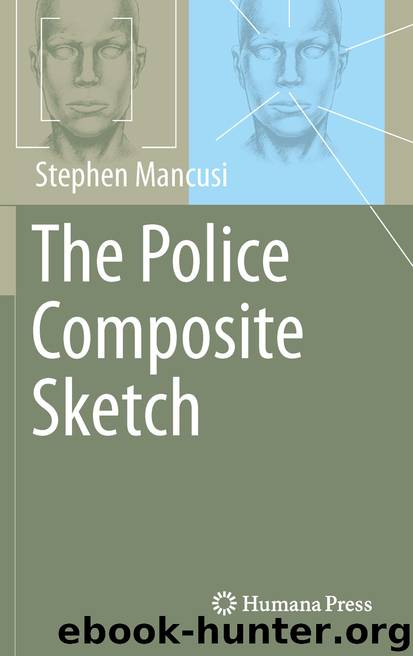The Police Composite Sketch by Stephen Mancusi

Author:Stephen Mancusi
Language: eng
Format: epub
Publisher: Humana Press, Totowa, NJ
The “crew cut,” “Caesar cut,” and “fade” are common terminologies of men’s short hairstyles. The crew cut or very close-cropped hair is sketched as an obvious hair shadow on the head. It may appear to have a very slight length. The Caesar cut is drawn as short hair. The hair length can appear up to one 16th of an inch. The hair is evenly cut over the whole of the hair mass. For Caucasian males, very short bangs may be present. The “fade” is mostly used to describe an African-American hairstyle. It appears as very close-cropped hair on the sides of the head and longer on the top. For today’s styles, the hair on the top is generally just a little longer than the hair on the sides (Fig. 5.31). However, in the past, the hair on the top did get much longer, creating some distinct shapes. Once in a while, these longer-style fades are still described. The fade styles are illustrated as a gradual transition from the shaven side hair to the longer top hair or as an abrupt distinction at the point when the hair becomes longer. This is the situation for a Mohawk hairstyle, which could be considered an extreme fade. Some fades are accompanied by designs chiseled into the hair on the side of the head. When this design element is being described, it should be clearly sketched on the composite in a visible location. These chiseled design elements are in the form of lines, words, objects, and shapes. They are a strong identifying characteristic.
Other common fade hairstyle descriptions will include “spiked,” color variations, and a “knotty” connotation. “Spiked” is drawn with a shorter hair length on the sides of the head and longer spike texture variations on the top. The hair on the top is drawn pointing straight up with a hard edge. Commonly, it will be a gelled texture. Often the top hair of the fade will be bleached and have a distinct lighter tonal appearance. Knotty textures along with other connotations can also be described as longer hair at the top of a faded hairstyle (Fig. 5.31).
Hairlines are often described by the witness or victim using words like “straight,” “curved,” “high,” “low,” “thick,” “pointy,” and “widow’s peak.” These references are suggested for shorter hairstyles. The hairline can appear almost perfectly straight across the forehead. In most cases, however, it will be described as an upward or downward curved line that contours to the skull and will be delineated as such. Not withstanding hair loss, even a thick head of hair can be described as high on the forehead. In contrast, thinning hair could also be described as low on the forehead. Thick hairlines are an element of texture. They are used in conjunction with descriptions of full heads of hair. A widow’s peak and pointy are similar hairlines. They are drawn with the center of the hairline extending forward as a bump or spike and with the ends of the hairline receding back onto the scalp.
Download
This site does not store any files on its server. We only index and link to content provided by other sites. Please contact the content providers to delete copyright contents if any and email us, we'll remove relevant links or contents immediately.
Periodization Training for Sports by Tudor Bompa(8170)
Why We Sleep: Unlocking the Power of Sleep and Dreams by Matthew Walker(6618)
Paper Towns by Green John(5089)
The Immortal Life of Henrietta Lacks by Rebecca Skloot(4525)
The Sports Rules Book by Human Kinetics(4294)
Dynamic Alignment Through Imagery by Eric Franklin(4116)
ACSM's Complete Guide to Fitness & Health by ACSM(3989)
Kaplan MCAT Organic Chemistry Review: Created for MCAT 2015 (Kaplan Test Prep) by Kaplan(3939)
Introduction to Kinesiology by Shirl J. Hoffman(3725)
Livewired by David Eagleman(3683)
The Death of the Heart by Elizabeth Bowen(3551)
The River of Consciousness by Oliver Sacks(3539)
Alchemy and Alchemists by C. J. S. Thompson(3449)
Bad Pharma by Ben Goldacre(3355)
Descartes' Error by Antonio Damasio(3230)
The Emperor of All Maladies: A Biography of Cancer by Siddhartha Mukherjee(3064)
The Gene: An Intimate History by Siddhartha Mukherjee(3047)
The Fate of Rome: Climate, Disease, and the End of an Empire (The Princeton History of the Ancient World) by Kyle Harper(3003)
Kaplan MCAT Behavioral Sciences Review: Created for MCAT 2015 (Kaplan Test Prep) by Kaplan(2936)
